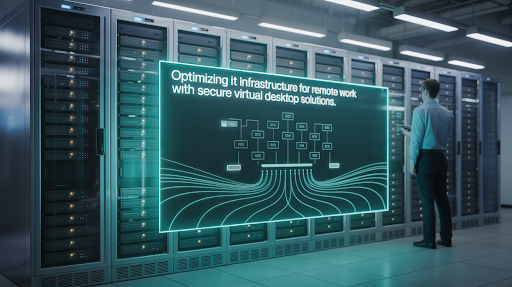Optimizing IT Infrastructure for Remote Work with Secure Virtual Desktop Solutions

Working remotely sounds easy, but managing IT systems for it can feel like herding cats. Many businesses struggle to provide secure and efficient access to their teams. From slow connections to security risks, these problems hurt productivity and trust. Did you know virtual desktop solutions can solve these headaches? This technology allows employees to access work environments from anywhere while keeping data safe on centralized servers.
Companies save money and enhance security with tools like this. In this blog, you’ll find practical tips on improving your IT setup using remote desktop solutions. We’ll also discuss the most suitable ones for your needs. Keep reading; the answers are just ahead!
Key Benefits of Secure Virtual Desktop Solutions
Secure virtual desktops create a protected digital workspace for remote teams. They make access easier while focusing on data protection.
Seamless Remote Accessibility
Remote desktop solutions enable employees to work from any location without performance concerns. Virtual desktop technology links users to centralized servers, providing a uniform experience across devices. Cloud computing enhances this process by lessening hardware reliance while increasing remote access efficiency. “Work efficiently and enhance productivity from any part of the world.” Centralized management allows IT teams to address issues remotely, maintaining minimal downtime and uninterrupted business operations.
Advanced Security and Compliance
Virtual desktop solutions protect sensitive data with advanced cybersecurity measures. These platforms store all critical information on centralized servers instead of individual devices. This setup reduces the risk of data breaches caused by theft or device loss.
Regular updates and compliance checks strengthen system defenses against threats like malware and phishing attacks. Businesses can meet data protection regulations more efficiently through built-in compliance tools. Providers like IT secured at Attentus offer tailored cybersecurity services that complement virtual desktop deployments with regulatory-grade protection. Explore flexible options to align security needs with company growth goals, as covered in the next section below.
Scalability and Flexibility
Businesses can easily grow virtual desktop environments as their teams expand. Adding new users or modifying resources takes minimal time, maintaining smooth operations. Small startups and large enterprises alike find this flexibility beneficial. Remote work demands often fluctuate. IT teams have the flexibility to increase or decrease resources based on employee workloads. This method reduces costs while addressing business needs effectively, ensuring dependable performance for everyone involved.
Cost Efficiency and Reduction
Switching to virtual desktop technology reduces hardware expenses. Businesses no longer need advanced computers for each employee. A basic device connects securely to a centralized server, decreasing IT costs significantly. Maintenance becomes easier with centralized management. IT teams resolve issues remotely without traveling between offices, saving time and money. Investing in virtual desktops often offsets costs by reducing unnecessary infrastructure expenses.
Explore powerful tools designed to simplify remote work, bolster security, and enhance flexibility at your fingertips.
Amazon WorkSpaces
Amazon WorkSpaces offers an easier way to set up desktop virtualization. This cloud-based solution provides virtual desktops that users can access from almost any device. It supports remote work by allowing employees to connect securely and efficiently, whether working from home or branch offices.
This platform focuses on cybersecurity with encryption for data at rest and in transit. IT administrators benefit from centralized management tools that simplify applying updates or managing user permissions. Its pay-as-you-go model helps businesses lower IT costs while offering flexibility to adjust as needed.
Azure Virtual Desktop
Azure Virtual Desktop provides businesses with secure remote desktop solutions designed for flexibility and control. It helps teams access virtual desktops from any location while maintaining centralized management. This tool simplifies IT infrastructure, offering a personalized virtual environment suited to specific company needs.
It supports cloud computing by hosting desktops and apps on Microsoft Azure servers. For businesses looking for expert help, an optimized AVD deployment with Atmosera can ensure a smooth rollout tailored to specific performance and compliance needs. Businesses save costs by avoiding expensive hardware upgrades, relying instead on adaptable resources in the cloud. Advanced security features like multi-factor authentication protect data from potential breaches or unauthorized access.
Citrix DaaS
Citrix DaaS offers businesses secure and efficient virtual desktop solutions designed for remote work. It provides a cloud-based platform that supports hybrid environments, making it suitable for teams with varying needs. IT administrators can centrally manage desktops while ensuring data security through strong encryption standards.
This solution excels in delivering reliable performance across different devices and locations. Employees gain uninterrupted access to their tools, increasing productivity even during peak usage times. Citrix DaaS quickly adapts to meet growing demands without straining IT infrastructure or budgets.
VMware Horizon Cloud
Switching from Citrix DaaS, VMware Horizon Cloud offers businesses versatility for hosting virtual desktops. It allows IT teams to centrally oversee applications and desktop environments from any cloud or on-premises infrastructure. This solution streamlines deployment while improving remote work by catering to various business needs.
Security remains a critical focus of VMware Horizon Cloud. With strong encryption and conditional access policies, it protects sensitive company data across devices. Its capacity to grow supports expanding teams without extensive changes to existing IT frameworks. Companies can also reduce costs by adjusting resources based on usage needs.
Choosing the Right Virtual Desktop Solution
Finding the right fit depends on understanding your team’s daily needs and challenges. Pick one that balances growth, security, and user experience without breaking the bank.
Assessing Business Needs
Identify specific challenges faced by your business. Consider aspects like team size, current IT infrastructure, remote work environments, and compliance requirements. Not all businesses share the same goals or technical needs. Focus on employee workflows and software compatibility. A solution that supports collaboration tools and offers secure access to centralized servers can save time while improving efficiency.
Evaluating Scalability and User Experience
Expanding IT infrastructure for remote work requires solutions that adjust easily and grow with demand. Virtual desktop technology supports businesses of all sizes by adapting resources based on employee count or workload spikes. This adaptability reduces the need for constant hardware updates, saving costs long-term.
A positive user experience keeps employees productive and motivated. Slow connections or complicated interfaces hurt efficiency and morale. Solutions that prioritize smooth access, straightforward design, and dependable performance allow teams to focus on tasks instead of troubleshooting issues.
Ensuring Security and Compliance
Protecting sensitive data starts with strong cybersecurity measures. Secure Virtual Desktop Solutions use centralized servers to store and manage information, reducing risks tied to endpoint devices. This approach prevents unauthorized access and limits potential breaches. Encryption protects transmitted data while multi-factor authentication adds another level of security.
Businesses also meet regulatory requirements by using these solutions. They include integrated compliance features for standards like GDPR or HIPAA, making audits easier. IT teams can control user permissions, monitor activities, and quickly resolve vulnerabilities through centralized management tools.
Conclusion
Remote work is here to stay, and businesses need secure solutions. Virtual desktop technology simplifies IT management while keeping data safe. It supports flexibility, reduces costs, and enhances efficiency. Choosing the right option depends on understanding your team’s needs. Make smart decisions today to create a strong foundation for tomorrow’s workforce.

Source: Optimizing IT Infrastructure for Remote Work with Secure Virtual Desktop Solutions

